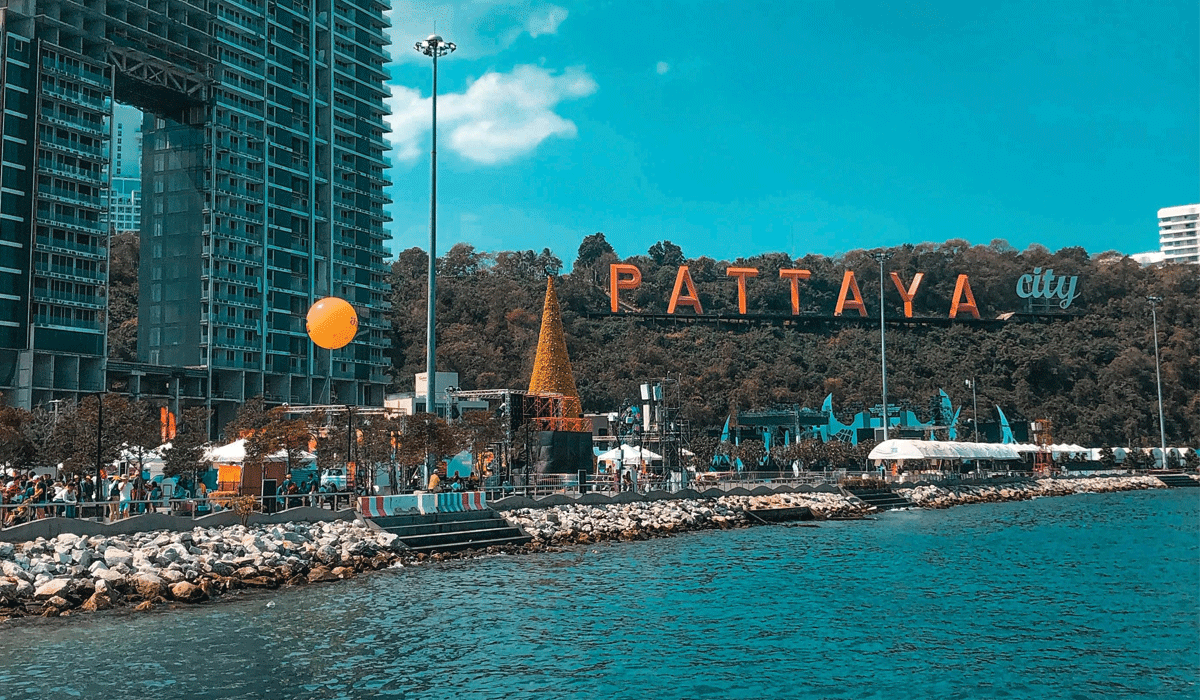
“In this human-made paradise, entertainment reigned supreme, and all forms of leisure had their whispered, rum-breathed price.”
- - -
A semi-regular guest column about regularly ignored places
- - -
Each year, as many as twenty-five million people visit the sacrificial landscape of Pattaya, Thailand. If visitors don’t arrive by air, then they likely take the eight-lane motorway that zips them along the eastern Thai seaboard from Bangkok to the shores of Chonburi province.
They come for rest and relaxation, purportedly. Frantic development over the decades has put Pattaya at a far remove from its past as a pristine, natural coastline. It’s a place made to concede itself. Disuse does not define the area’s state of wild abandonment, but rather the hedonistic exploitation and exhaustion of land and sea in a bargain for economic prosperity.
In my 1980s childhood, my family often enjoyed weekend stays on the shores of nearby Bang Saen—at the time a tranquil beach, with tall coconut trees and beach morning glories that grew between small bungalows and seafood eateries catering to Thai vacationers—and we’d also usually drive a little farther south on Sukhumvit Road to Pattaya. The beaches by then had already been given over to unfettered tourism, and each visit offered something new to ooh and aah about: barely finished high-rise condominiums casting shadows across the sand; newly constructed luxury hotels looking out over wide blue pools lined with sunbathing, bare-chested foreign guests; and down by the waves, shacks that had popped up to rent rigs and offer boats for recently introduced beach activities, like windsurfing, parasailing, scuba diving, and, most noisomely, Jet Skiing.
Nights in Pattaya were eye-openers for a child. Thoroughfares along the beaches came alive with bar girls dancing under pink neon lights and sunburned Europeans cheering live muay Thai matches. Nightclubs, cabarets, and sex shows welcomed all who carried cash. In this human-made paradise, entertainment reigned supreme, and all forms of leisure had their whispered, rum-breathed price.
The philosopher Marc Augé coined the term non-place to describe geographies interrupted by supermodernity and cleansed of their anthropological relationships, histories, and identities to function as conduits of globalized systems. For me, the term non-place also describes an entire ecological locale that has been reset, its natural history and diversity turned over and remade to serve outside demands—in Pattaya, the transient touristic populations that flow through daily.
Pattaya used to be a little-known seaside village, inhabited by a few hundred people split into two small fishing communities. Historical records describe an almost-two-mile sandy beach where villagers kept their boats during severe monsoons, protected by the islands of Koh Larn and Koh Sak. Marine life thrived, with abundant coral reefs and undisturbed nesting beaches for sea turtles. Palms grew thick along the southernmost shores, and the villagers called the area Palmyra Beach, later renamed Jomtien for a princess from the mythical kingdom said to exist there in a hidden realm.
Then came violent change as war escalated in Southeast Asia. In the 1960s, with the Vietnam War buildup, US soldiers stationed at military bases around the country came looking for a good time. Pattaya’s lore describes an initial truck convoy of a few hundred GIs descending on the village to rent beach houses. The drunken, sordid revelries shattered the tranquility, and Pattaya found itself rocking-and-rolling to accommodate the influx of American military personnel (almost fifty thousand at the peak of the war, with many others from elsewhere).
The ensuing highway construction in the 1970s turned Sukhumvit Road into Highway 3, and many new hotels opened to welcome the visitors now arriving from seemingly everywhere in the world. Around the time of my childhood visits, the tourism-industrial complex in Pattaya was ramping up, securing investment to build nearly 850 vacation properties by 2015; that figure has more than doubled since then, growing outward and upward from the restless beaches.
The effects are palpable—and smellable. Wherever overwhelming numbers of people gather to feast and frolic, they also foul up the place. In Bangkok, I often heard cautions about visiting Pattaya unless one wanted skin rashes. A 2016 study by the Regional Environmental Office said that the waters at Pattaya’s central beach could endanger human life, a warning apparently unheard by beachgoers who still leaped into the frothy waves. In recent years, viral photos and videos on social media have shown viscous wastewater gushing from culverts, and Pattaya and Jomtien beaches covered in sewage. Officials claimed the situation was under control, after expensive treatment plants were built, but at some point later, the sewage-dark sea returned.
Meanwhile, environmental externalities have been so distantly externalized that they keep washing back ashore. Careless boat operators, staffers and guests at nearby island venues, and beach tourists routinely get caught throwing garbage into the sea, with litter appearing on beaches, and ecologically sensitive islands declared off-limits by the navy, to protect wildlife. Almost a hundred thousand tons of garbage piled up on the popular island of Koh Larn before being buried, against the wishes of residents who fear seepage. In Pattaya, a walk along the sand to collect seashells could net a variety of items, including plastic containers, strips of fishing nets, car tires, discarded foam, broken beer bottles, and medical waste, among other delightful finds.
This is not exactly a tragic commons; both governmental regulations and high levels of investment in beach real estate and tourist operations have so far proved insufficient to compel better environmental practices. There’s no commons to be sustainably managed, because the here and now is a fluctuating, destabilized locus of transactions with a sunny beachfront. All-consuming activity reigns supreme when the continuity of a fragile marine ecosystem becomes secondary to the unrestricted fun of a global party city.
And come the wild bunch have from all over, not just for good times but also for illicit freedoms. The homegrown seediness that first attracted American GIs has deteriorated into a cosmopolitan free-for-all in the city’s underworld. Russian organized crime arrived after the collapse of the Soviet Union. Their unlawful presence in Pattaya, often denied by Thai officials, was confirmed by leaked US embassy cables mentioning Russian mob involvement in the “commission of numerous crimes, including extortion, money laundering, narcotics trafficking, real estate fraud, financial fraud, human smuggling, pandering, counterfeiting, document fraud, cybercrime, and illegal importation of cars.” They’ve since been joined by Chinese gangsters known for online gambling operations and investment scams in this anything-goes city.
In Pattaya, an unnatural paradise has arisen out of the marine idyll. External funding and top-down placemaking have meant the cultivation of any permissible earthly delight to lure an international target clientele to the region. This lucrative model has been re-created in Thailand’s other seaside tourism hubs, such as the islands of Phuket and Koh Samui, both of which have seen similar effects from natural degradation and socio-cultural erasure.
Pattaya’s tourism operators now say they’re done with the “sin city” image. They want to rebrand Pattaya as a cleaner, more enriching, family-friendly destination. The proposed solution: a casino.
- - -
Read other essays, plus interviews, advice columns, poems, reviews, and more over at The Believer.





